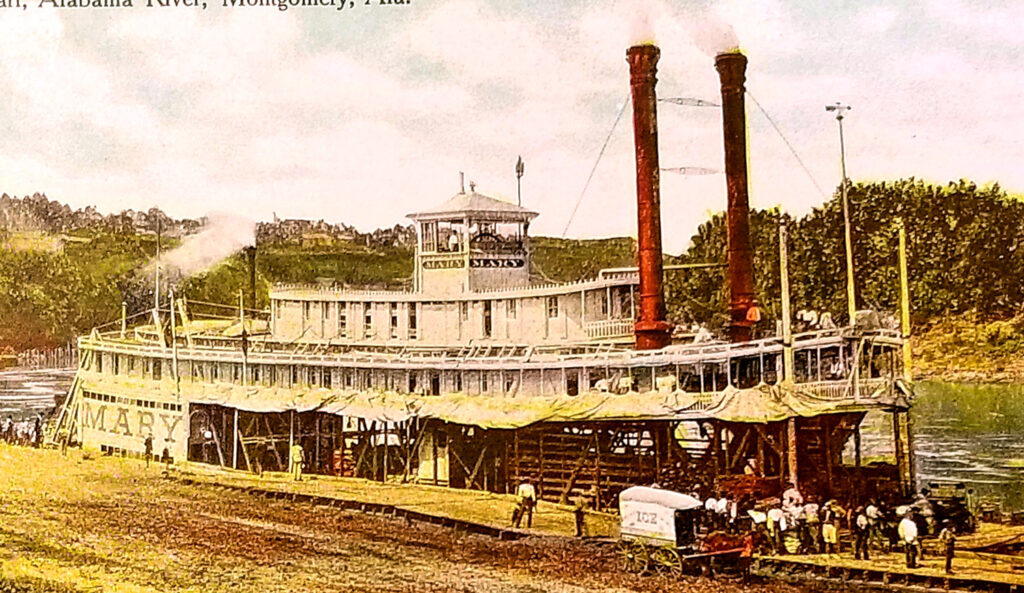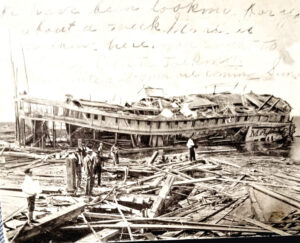
When Hurricane Helene struck yesterday, I could not help but recall a column I wrote several years ago about the Alabama steamboat Mary and the Hurricane of Sept. 27, 1906. I found it interesting that 118 years to the day another hurricane had devastated the Gulf Coast and just last week I came across a circa 1905 postcard of the Mary.
The Mary was a 198-ton stern wheeler built in 1899 that was engaged mostly in the Alabama River trade out of Mobile. She had beautiful lines, but I have two photographs of her as a crushed wreck. She was destroyed by the wind and storm surge of the Gulf Coast hurricane of 1906.
Although the weather service called 1906 an average year for hurricanes, the Atlantic hurricane season that year saw two tropical storms and four hurricanes, including two Category 3 storms, strike the Atlantic and Gulf coasts. On Sept. 27, 1906, a Category 3 storm that weakened to a Category 2 just as it made landfall east of Pascagoula wreaked havoc from Pensacola to New Orleans and into north Alabama and Mississippi.
As the storm slammed into the Gulf Coast, those west of the eye were spared major damage although as far west as New Orleans the effects were felt. There the damage was caused by storm waters surging into Lake Pontchartrain which overflowed into the city causing major flooding.
Those located east of the eye received the horrific full brunt of the storm. Winds of 120 mph were recorded, and the storm’s surge was estimated to be 11 feet. (Helene’s winds were reported to be 140 mph prior to landfall with a storm surge of more than 15 feet.)
There was major damage in Pensacola where reports in the Chattanooga Daily Times of Sept. 29 stated, “The worst sea storm and hurricane that the Gulf coast has experienced since the village of Pensacola, on San Rosa Island was swept away 170 years ago, began Wednesday night and is still raging. Every house in the city has suffered damage … the waterfront is strewn with wreckage for miles on either side of the city, and vessels are piled on the wharves, or where the wharves were, in utter ruin. Big iron steamers, and many larger sailing ships, are now lying high up in the city where the tide has never known to have reached before, and every wharf for miles around has been swept away or is damaged beyond repair.
It is known, however, that many of the houses in that section are now under from 5 to 10 feet of water, and many women have been taken from the second story windows and carried to safety in boats.”
Another report provided additional details. “The railroad wharf at Pensacola is reported to be a total loss and thirty-nine cars of coal of the company were washed into the bay.”
The first reports out of Mobile were made by the editor of the Mobile Register and the Louisville and Nashville telegraph operator. They had made their way by boat and on foot to Bay Minette where the telegraph was still working. They reported, “a number of lives lost in the tropical hurricane and much damage done to property in the city of Mobile. Many people were injured in the collapse of buildings. A great many ships and one or two revenue cutters were sunk, and their crews drowned. The city is practically under control of the militia and no one is permitted on the street except newspaper men and those wearing badges. … A large number of houses were destroyed. Bienville square has been destroyed. Christ Church cathedral was blown down. The wind reached a velocity of ninety miles an hour.” Another report stated that the Militia had been instructed to shoot looters. The known death toll along the coast was 134.
The damage was particularly devastating along the Mobile waterfront. Details of the damaged shipping were provided in the Montgomery Advertiser and the Chattanooga Daily Times. “The depth of the water in the wholesale district, which included the entire section of the city from Royal Street to the river, was seven feet. … Wharves from Frascati, the extreme south end of the city, as far up the river as Three Mile Creek, are total wrecks.”
Among the hundreds of vessels sunk were the Upper Tombigbee trade steamboats Mary E. Staples, Mary S. Blees and the Hattie B. Moore. The Mary Blees and Mary Staples were raised and repaired. The Hattie B. Moore was a total loss. The Alabama River steamer Mary, whose wrecked image stirred my interest, was described as “only damaged.”
As the storm drifted north through Mississippi, it left a trail of destruction. The national press reported that the brick wall of a hotel in Macon was blown down, killing two persons. However, according to the Macon Beacon, that was a hotel in McComb not Macon. Though there were no recorded local deaths, three cousins of Miss Charlee Garner of Columbus drowned in Mobile. The best description of the storm’s impact locally appeared in the Macon Beacon on Sept. 29.
“Probably the worst storm that ever struck this county at this time of year, with the greatest damage to cotton crop, started with a slow rain before day on Wednesday morning and continued unabated until 8 o’clock Thursday night, the wind coming in gusts and occasionally reaching a high rate of speed. In town, great many trees were blown down … the street presented a wrecked appearance on Thursday evening.”
In Starkville, the Oktibbeha County fair was canceled because of threatening weather. It was the heavy rains that caused the most damage across north Mississippi and resulted in flooded creeks and rivers. Macon reported receiving almost 40 hours of unabated rain. Just as Helene has spread its devastation inland through Tennessee, Georgia and the Carolinas, the September storm of 1906 caused flooding across mid America with Memphis receiving steady rain for 36 hours.
Thanks to Carolyn Kaye for helping with research.
Rufus Ward is a Columbus native a local historian. E-mail your questions about local history to Rufus at [email protected].
You can help your community
Quality, in-depth journalism is essential to a healthy community. The Dispatch brings you the most complete reporting and insightful commentary in the Golden Triangle, but we need your help to continue our efforts. In the past week, our reporters have posted 49 articles to cdispatch.com. Please consider subscribing to our website for only $2.30 per week to help support local journalism and our community.





